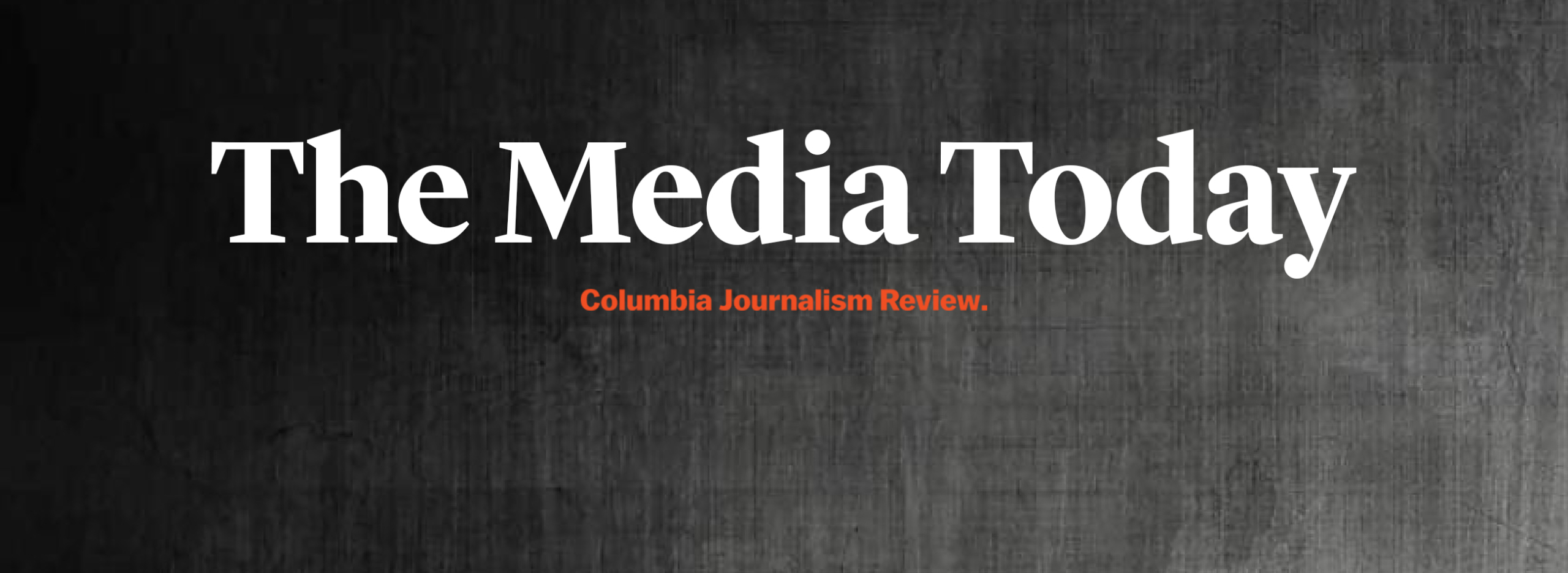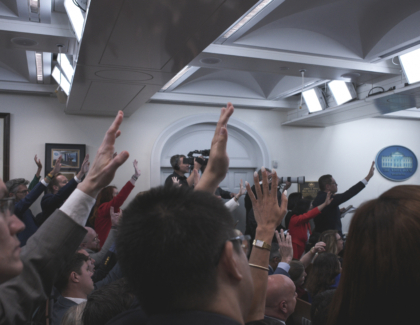Sign up for the daily CJR newsletter.
Over the past several months, technology journalists have had to get used to a new concept: the “non-fungible token,” or NFT, a concept that has been lighting up the cryptocurrency world, as well as art and media. An NFT is a string of code that, once it has been “minted” (generated by a computer) resides on the Ethereum blockchain, a ledger of every transaction since the currency was created. The “non-fungible” part just means that a token can’t be exchanged for another string of similar code, so it’s unique. What has made this phenomenon so compelling is that these tokens can be associated with specific real-world objects: pieces of art, such as the digital canvas created by an artist named Beeple that sold for $69 million, clips of NBA highlights, or even newspaper articles — such as the New York Times piece by Kevin Roose about NFTs that recently sold for $560,000 (the paper donated the money to charity).
In many cases, the people buying pieces of digital art for $69 million or a single news article for half a million dollars are cryptocurrency “whales” — investors who bought Bitcoin or Ethereum early and have seen their investments increase as Bitcoin has risen by more than 600 percent. Others run auction platforms for NFTs or other cryptocurrency trading systems, and likely see spending those kinds of sums as marketing. So is all of this just Las Vegas casino-style froth, or is there something of real value happening — something that could benefit the media industry and journalism? To answer those and other questions, we used CJR’s Galley discussion platform to bring together a number of experts, including Jarrod Dicker, vice president, commercial for the Washington Post; Emily Bell, director of the Tow Center for Digital Journalism at Columbia; developer Julien Genestoux; Elizabeth Lopatto, deputy editor of The Verge; and Josh Quittner, co-founder and chief executive of Decrypt Media.
Dicker, who was involved in a cryptocurrency venture called Poet before he joined the Post, said that his primary interest in NFTs is as a way of bringing “an ownership element back to media” and put more value on individuals and the work they create. “If we as content creators are able to manage control of assets at the inception of the idea, what dynamics come about that give us more creative control, monetization and agency?” he asked. “This gives both control as to how that content is used, licensed and distributed as well as a means to be able to collect revenue.” The Tow Center is looking at NFTs because “the idea of authentic, distributed systems that can be verified and controlled away from central entities should appeal to journalism,” Bell said. Bell was on the advisory council for Civil, a blockchain-powered platform for independent journalism that eventually shut down last year, and says she liked the idea of funding journalism via “more community-based methods.”
Related: How the culture war is impeding necessary scrutiny of ‘vaccine passports’
Lopatto said a sense of community is likely to be crucial if media or journalism is to get much out of the NFT craze. “If we’re going to take them seriously as assets, we need to talk about who’d be buying them,” she said. “It’s great in theory to have people out there swapping an NFT of one of my articles forever — but is anyone actually going to do that? I need to have a following of people who like me and want to ‘own’ my work, or there’s no market. Does your outlet have hard-core fans who will buy to support you?” Genestoux said his startup, called Unlock, is trying to use the blockchain to help media companies control access to their content. For example, he says, publishers could use his service to allow readers who have paid for access to an article to share a link, along with a slice of their membership to allow that person to read it without paying. Cuen noted that one important aspect of an NFT is that it doesn’t really give anyone specific rights to a physical object — the code is just a kind of digital receipt noting that the person has paid with a cryptocurrency.
“I can take a piece of paper and write down ‘Steve Jobs’ black turtleneck, $100′ and hand it to my friend [but] I never owned the maverick’s sweater,” she says. “An NFT is not proof of owning anything. It is only proof that I used a blockchain.” Cryptocurrency advocates like Dicker note that technically this is true, but the physical deed that a homeowner gets when they buy their house is also a kind of a receipt, and could be forged. The benefit of the blockchain ledger, these advocates say, is that it keeps track of every transaction, which creates a record of provenance. If someone tried to mint an NFT for something they didn’t own, it would be relatively easy to prove that it was fake. And despite the risk, some are already experimenting with the prospect of using NFTs for their journalism, including Quittner at Decrypt Media (which is funded by ConsenSys, a cryptocurrency fund that also backed Civil). He says Decrypt just launched crypto tokens that readers can exchange for various features on the site, and even turn into tradable NFTs.
Here’s more on cryptocurrency:
- Unpalatable truth: Bell says the idealism of new financial platforms is prone to some of the same problems as the idealism of new speech platforms such as Facebook. “It’s all fun and games until you instigate a violent coup, and then see bits of the Capitol riots traded through NFTs.” The real issue for journalism, Bell says, is that “not enough people want to voluntarily pay for it to sustain the amount of journalism we need to cover every community. It doesn’t matter if you chop it into a thousand pieces and upload it to the blockchain, that very unpalatable truth remains non-fungible.”
- Built on trust: Open up the $69 million NFT that Beeple sold at Christie’s, and you won’t find much, says The Verge. “The name of the artwork isn’t there. The name of the artist is missing. And crucially, you won’t even find the actual piece of art. That’s not a flaw in Beeple’s NFT — it’s just how the system works. It turns out, the house of cards that is the NFT system is even more precarious than it first appears.” NFTs are fundamentally built on trust, the Verge piece points out: trust that a seller won’t screw you over, trust that these tokens magically have value. Ultimately, “you’re buying a collection of metadata.”
- The worst tendencies: Nathan Schneider, a media studies professor, says he wonders whether we are generating democratic communities via cryptocurrency or “are we creating more commodities through which the rich can get richer? It is nice that some artists are making some money lately, but I don’t think this is the path toward an economy of creativity that will be especially sustainable, particularly for artists and culture-bearers in already marginalized communities. I would love to be proven wrong, but I’m concerned that we’re using new tech to amplify precisely the worst existing tendencies of the art-world.”
- Opportunism: Anil Dash, the chief executive of Glitch, a collaborative programming platform, says when he helped invent non-fungible tokens seven years ago, he and a partner were trying to protect artists, but now “tech-world opportunism has struck again.” Dash says he and artist Kevin McCoy came up with the idea during a hackathon in New York City in 2014. “I was working as a consultant to auction houses and media companies — a role that had me obsessively thinking about the provenance, ownership, distribution, and control of artworks. By the wee hours of the night, McCoy and I had hacked together a first version of a blockchain-backed means of asserting ownership over an original digital work.”
Other notable stories:
- CBS has ousted two powerful TV station executives following allegations of racist and abusive behavior, the Los Angeles Times reported. Peter Dunn, who served as president of the TV Stations group since 2009, and David Friend, the senior vice president of news for more than a decade, are no longer part of CBS, the company’s chief executive, George Cheeks, said Wednesday in an email to staff. The move comes two months after an investigation by the Times alleged that the pair cultivated an environment that included bullying female managers and blocking efforts to hire and retain Black journalists.
- Reuters released its first annual diversity report, which shows that the company’s newsrooms, especially in the US, are overwhelmingly white and male. Joyce Adeluwoye-Adams, Reuters’ Editor of Newsroom Diversity, said in a pre-release statement that “As we expected, the data to date highlights some clear areas for improvement. Our organization is not as diverse as the societies we serve and the problem is particularly acute amongst leadership roles. This needs to change if we want to continue to be a successful global newsroom covering the world in all its depth.”
- Danielle Kwateng was announced as Teen Vogue’s new executive editor Wednesday. The announcement came in the form of a tweet from the publication’s account, which The Wrap said was noteworthy because the account hasn’t posted anything since the March announcement that Alexi McCammond would be the new editor in chief. McCammond later withdrew her name before even starting the job. Kwateng, formerly Teen Vogue’s entertainment and culture director, released a note to readers Wednesday.
- Andrew Rosenthal, former editorial page editor of the New York Times, is joining a struggling Swedish news startup called Bulletin, despite the fact that he admits he doesn’t speak or read the language, and doesn’t know much about the country’s politics. “It’s not my job to figure out Swedish politics, and it’s not my job to influence the Opinion pages,” Rosenthal told Vanity Fair. “The purpose here is to stand up a functioning news organization.”
- Brooke Baldwin, a former CNN news anchor who recently announced she is leaving the network after 13 years, opened up this week about gender pay disparity at the network, according to a report by The Wrap. “The most influential anchors on our network — the highest-paid — are men. My bosses, my executives, are men. The person who oversees CNN Dayside is a man and my executive producer for 10 years is a man, so I’ve been surrounded by a lot of men,” Baldwin said while reflecting on her decade at the network during an appearance on Ms. Magazine’s “On the Issues” podcast.
- Gimlet Media and The Ringer agreed on a three-year union employment contract with Spotify, marking a historic moment for both the tech giant and the podcasting industry, according to The Verge (whose employees are part of the same union). The contracts cover diversity at the company, salary bases, annual raises, and titles. It’s a big step — not just for unionization in podcasting, but also for the tech industry overall, which has been resistant to take up unionization.
- YouTube saw the most significant growth of any social media app among American users during the pandemic, the Pew Research Center reported in a new report released Wednesday. The Google-owned video service saw usage grow from 73 percent of U.S. adults in 2019 to 81 percent in 2021. That was followed most closely by Reddit, which saw usage grow from 11 percent of U.S. adults in 2019 to 18 percent in 2021. The conclusions are from a survey of 1,502 U.S. adults conducted between January 25 and February 8.
- Atlantic Media released a statement admitting that on March 1, it became aware that an unauthorized actor had accessed the magazine’s servers. According to the company, which is now a minority shareholder in the magazine following its purchase by Laurene Powell Jobs, the forensic investigation found no evidence that any subscribers’, customers’, or clients’ financial or sensitive information was involved, but did find that portions of the network file server “were potentially briefly accessible to the unauthorized actors.” The potentially accessible folders included one containing W-2 forms, W-9 forms, and other tax documents that contained names and Social Security Numbers of employees.
ICYMI: The ‘Diversity Hire’ podcast talks about racism in media
Has America ever needed a media defender more than now? Help us by joining CJR today.







